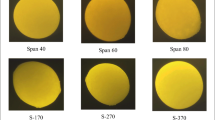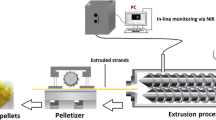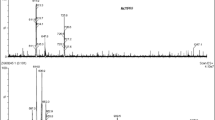Abstract
Paraffin wax is a hydrophobic meltable material that can be suitably used in spray congealing to develop drug-loaded microparticles for sustained release, taste-masking or stability enhancement of drugs. However, these functional properties may be impaired if the drug particles are not completely embedded. Moreover, highly viscous melts are unsuitable for spray dispersion. In this study, the effects of drug particle size and lipid additives, namely stearic acid (SA), cetyl alcohol (CA) and cetyl esters (CE), on melt viscosity and extent of drug particles embedment were investigated. Spray congealing was conducted on the formulations, and the resultant microparticles were analysed for their size, drug content, extent of drug particles embedment and drug release. The melt viscosity increased with smaller solid inclusions while lipid additives decreased the viscosity to varying extents. The spray-congealed microparticle size was largely dependent on the viscosity. The addition of lipid additives to paraffin wax enabled more complete embedment of the drug particles. CA produced microparticles with the lowest drug release, followed by SA and CE. The addition of CA and CE enhanced the drug release and showed potential for taste-masking. Judicious choice of drug particle size and matrix materials is important for successful spray congealing to produce microparticles with the desired characteristics.




Similar content being viewed by others
References
Sohi H, Sultana Y, Khar RK. Taste masking technologies in oral pharmaceuticals: recent developments and approaches. Drug Dev Ind Pharm. 2004;30(5):429–48.
Shiino K, Iwao Y, Miyagishima A, Itai S. Optimization of a novel wax matrix system using aminoalkyl methacrylate copolymer E and ethylcellulose to suppress the bitter taste of acetaminophen. Int J Pharm. 2010;395(1–2):71–7.
Oh CM, Guo Q, Heng PWS, Chan LW. Spray-congealed microparticles for drug delivery – an overview of factors influencing their production and characteristics. Expert Opin Drug Deliv. 2014;11(7):1047–60.
Ilić I, Dreu R, Burjak M, Homar M, Kerč J, Srčič S. Microparticle size control and glimepiride microencapsulation using spray congealing technology. Int J Pharm. 2009;381(2):176–83.
Passerini N, Perissutti B, Albertini B, Franceschinis E, Lenaz D, Hasa D, et al. A new approach to enhance oral bioavailability of Silybum marianum dry extract: association of mechanochemical activation and spray congealing. Phytomedicine. 2012;19(2):160–8.
Wong PCH, Heng PWS, Chan LW. Spray congealing as a microencapsulation technique to develop modified-release ibuprofen solid lipid microparticles: the effect of matrix type, polymeric additives and drug–matrix miscibility. J Microencapsul. 2015;32(8):725–36.
Reithmeier H, Herrmann J, Göpferich A. Development and characterization of lipid microparticles as a drug carrier for somatostatin. Int J Pharm. 2001;218(1–2):133–43.
Rodriguez L, Albertini B, Passerini N, Cavallari C, Giovannelli L. Hot air coating technique as a novel method to produce microparticles. Drug Dev Ind Pharm. 2004;30(9):913–23.
Albertini B, Passerini N, Pattarino F, Rodriguez L. New spray congealing atomizer for the microencapsulation of highly concentrated solid and liquid substances. Eur J Pharm Biopharm. 2008;69(1):348–57.
Di Sabatino M, Albertini B, Kett VL, Passerini N. Spray congealed lipid microparticles with high protein loading: preparation and solid state characterisation. Eur J Pharm Sci. 2012;46(5):346–56.
McCarron PA, Donnelly RF, Al-Kassas R. Comparison of a novel spray congealing procedure with emulsion-based methods for the micro-encapsulation of water-soluble drugs in low melting point triglycerides. J Microencapsul. 2008;25(6):365–78.
Martins RM, Siqueira S, Machado MO, Freitas LAP. The effect of homogenization method on the properties of carbamazepine microparticles prepared by spray congealing. J Microencapsul. 2013;30(7):692–700.
Maschke A, Becker C, Eyrich D, Kiermaier J, Blunk T, Göpferich A. Development of a spray congealing process for the preparation of insulin-loaded lipid microparticles and characterization thereof. Eur J Pharm Biopharm. 2007;65(2):175–87.
Taguchi K, Iwami K, Ibuki F, Kawabata M. Oxidative stability of sardine oil embedded in spray-dried egg white powder and its use for n-3 unsaturated fatty acid fortification of cookies. Biosci Biotechnol Biochem. 1992;56(4):560–3.
Lin C-C, Lin S-Y, Hwang LS. Microencapsulation of squid oil with hydrophilic macromolecules for oxidative and thermal stabilization. J Food Sci. 1995;60(1):36–9.
Wanasundara UN, Shahidi F. Storage stability of microencapsulated seal blubber oil. J Food Lipids. 1995;2(2):73–86.
Sinha VR, Trehan A. Biodegradable microspheres for protein delivery. J Control Release. 2003;90(3):261–80.
Deasy PB. General introduction to microencapsulation and related drug processes. New York: M. Dekker; 1984.
Akiyama Y, Yoshioka M, Horibe H, Hirai S, Kitamori N, Toguchi H. Novel oral controlled-release microspheres using polyglycerol esters of fatty acids. J Control Release. 1993;26(1):1–10.
Uchida T, Tanigake A, Miyanaga Y, Matsuyama K, Kunitomo M, Kobayashi Y, et al. Evaluation of the bitterness of antibiotics using a taste sensor. J Pharm Pharmacol. 2003;55(11):1479–85.
Qi S, Deutsch D, Craig DQM. An investigation into the interaction between taste masking fatty acid microspheres and alkaline buffer using thermal and spectroscopic analysis. J Pharm Sci. 2006;95(5):1022–8.
Yajima T, Nogata A, Demachi M, Umeki N, Itai S, Yunoki N, et al. Particle design for taste-masking using a spray-congealing technique. Chem Pharm Bull (Tokyo). 1996;44(1):187–91.
Yajima T, Umeki N, Itai S. Optimum spray congealing conditions for masking the bitter taste of clarithromycin in wax matrix. Chem Pharm Bull (Tokyo). 1999;47(2):220–5.
Yajima T, Fukushima Y, Itai S, Kawashima Y. Method of evaluation of the bitterness of clarithromycin dry syrup. Chem Pharm Bull (Tokyo). 2002;50(2):147–52.
Yajima T, Itai S, Takeuchi H, Kawashima Y. Optimum heat treatment conditions for masking the bitterness of the clarithromycin wax matrix. Chem Pharm Bull (Tokyo). 2003;51(11):1223–6.
Passerini N, Albertini B, Perissutti B, Rodriguez L. Evaluation of melt granulation and ultrasonic spray congealing as techniques to enhance the dissolution of praziquantel. Int J Pharm. 2006;318(1–2):92–102.
Quadir MA, Rahman MS, Karim MZ, Akter S, Awkat MTB, Reza MS. Evaluation of hydrophobic materials as matrices for controlled-release drug delivery. Pak J Pharm Sci. 2003;16(2):17–28.
Savolainen M, Herder J, Khoo C, Lövqvist K, Dahlqvist C, Glad H, et al. Evaluation of polar lipid–hydrophilic polymer microparticles. Int J Pharm. 2003;262(1–2):47–62.
Savolainen M, Khoo C, Glad H, Dahlqvist C, Juppo AM. Evaluation of controlled-release polar lipid microparticles. Int J Pharm. 2002;244(1–2):151–61.
Jaspart S, Piel G, Delattre L, Evrard B. Solid lipid microparticles: formulation, preparation, characterisation, drug release and applications. Expert Opin Drug Deliv. 2005;2(1):75–87.
Passerini N, Perissutti B, Moneghini M, Voinovich D, Albertini B, Cavallari C, et al. Characterization of carbamazepine-gelucire 50/13 microparticles prepared by a spray-congealing process using ultrasounds. J Pharm Sci. 2002;91(3):699–707.
Passerini N, Perissutti B, Albertini B, Voinovich D, Moneghini M, Rodriguez L. Controlled release of verapamil hydrochloride from waxy microparticles prepared by spray congealing. J Control Release. 2003;88(2):263–75.
Bodmer D, Kissel T, Traechslin E. Factors influencing the release of peptides and proteins from biodegradable parenteral depot systems. J Control Release. 1992;21(1):129–37.
Bodmer D, Fong JW, Kissel T, Maulding HV, Nagele O, Pearson JE, inventors; Novartis AG, assignee. Sustained release formulations of water soluble peptides. United States patent US5538739A. 1996.
Rodriguez L, Passerini N, Cavallari C, Cini M, Sancin P, Fini A. Description and preliminary evaluation of a new ultrasonic atomizer for spray-congealing processes. Int J Pharm. 1999;183(2):133–43.
Park SB, Kang HW, Haam S, Park HY, Kim WS. Ca-alginate microspheres encapsulated in chitosan beads. J Microencapsul. 2004;21(5):485–97.
Bilati U, Allémann E, Doelker E. Strategic approaches for overcoming peptide and protein instability within biodegradable nano- and microparticles. Eur J Pharm Biopharm. 2005;59(3):375–88.
Kulthe VV, Chaudhari PD. Effectiveness of spray congealing to obtain physically stabilized amorphous dispersions of a poorly soluble thermosensitive API. AAPS PharmSciTech. 2014;15(6):1370–7.
Oh CM, Heng PWS, Chan LW. Influence of hydroxypropyl methylcellulose on metronidazole crystallinity in spray-congealed polyethylene glycol microparticles and its impact with various additives on metronidazole release. AAPS PharmSciTech. 2015;16(6):1357–67.
Albertini B, Perissutti B, Bertoni S, Zanolla D, Franceschinis E, Voinovich D, et al. Combining mechanochemistry and spray congealing for new praziquantel pediatric formulations in schistosomiasis treatment. Int J Mol Sci. 2019;20(5):1233.
Bertoni S, Albertini B, Ferraro L, Beggiato S, Dalpiaz A, Passerini N. Exploring the use of spray congealing to produce solid dispersions with enhanced indomethacin bioavailability: in vitro characterization and in vivo study. Eur J Pharm Biopharm. 2019;139:132–41.
Scott MW, Robinson MJ, Pauls JF, Lantz RJ. Spray congealing: particle size relationships using a centrifugal wheel atomizer. J Pharm Sci. 1964;53(6):670–5.
Albertini B, Passerini N, González-Rodríguez ML, Perissutti B, Rodriguez L. Effect of Aerosil® on the properties of lipid controlled release microparticles. J Control Release. 2004;100(2):233–46.
Eldem T, Speiser P, Hincal A. Optimization of spray-dried and -congealed lipid micropellets and characterization of their surface morphology by scanning electron microscopy. Pharm Res. 1991;8(1):47–54.
Cusimano AG, Becker CH. Spray-congealed formulations of sulfaethylthiadiazole (SETD) and waxes for prolonged-release medication. Effect of wax. J Pharm Sci. 1968;57(7):1104–12.
Wong PCH, Heng PWS, Chan LW. Viscosity–temperature relationship of lipid-based excipients amenable for spray congealing: derivation of a rheological parameter with good correlation to particle size. Eur J Lipid Sci Technol. 2016;118(7):1062–73.
Fischer-Tropsch waxes 2018 [cited 2018 19 March 2018]. Available from: http://www.sasolwax.com/index.php?id=fischer_tropsch_wax.
Ouyang H, Zheng AY, Heng PWS, Chan LW. Effect of lipid additives and drug on the rheological properties of molten paraffin wax, degree of surface drug coating, and drug release in spray-congealed microparticles. Pharmaceutics. 2018;10(3):75.
Martins RM, Siqueira S, Freitas LAP. Spray congealing of pharmaceuticals: study on production of solid dispersions using Box-Behnken design. Dry Technol. 2012;30(9):935–45.
Lopes JD, Grosso CRF, de Andrade Calligaris G, Cardoso LP, Basso RC, Ribeiro APB, et al. Solid lipid microparticles of hardfats produced by spray cooling as promising crystallization modifiers in lipid systems. Eur J Lipid Sci Technol. 2015;117(11):1733–44.
Duarte Í, Andrade R, Pinto JF, Temtem M. Green production of cocrystals using a new solvent-free approach by spray congealing. Int J Pharm. 2016;506(1–2):68–78.
Cavallari C, Gonzalez-Rodriguez M, Tarterini F, Fini A. Image analysis of lutrol/gelucire/olanzapine microspheres prepared by ultrasound-assisted spray congealing. Eur J Pharm Biopharm. 2014;88(3):909–18.
Stearic Acid [Internet]. National Center for Biotechnology Information. 2018 [cited 11 December 2018]. Available from: https://pubchem.ncbi.nlm.nih.gov/compound/stearic_acid#section=Top.
Cetyl Alcohol [Internet]. National Center for Biotechnology Information. 2018 [cited 11 December 2018]. Available from: https://pubchem.ncbi.nlm.nih.gov/compound/1-Hexadecanol#section=Top.
Cetyl Palmitate [Internet]. Royal Society of Chemistry. 2018 [cited 11 December 2018]. Available from: http://www.chemspider.com/Chemical-Structure.10427.html.
Acetaminophen [Internet]. National Center for Biotechnology Information. 2018 [cited 11 December 2018]. Available from: https://pubchem.ncbi.nlm.nih.gov/compound/acetaminophen#section=Top.
Mendyk A, Jachowicz R, Fijorek K, Dorozynski P, Kulinowski P, Polak S. KinetDS: an open source software for dissolution test data analysis. Dissolut Technol. 2012;19(1):6–11.
Moore JW, Flanner HH. Mathematical comparison of dissolution profiles. Pharm Technol. 1996;20(6):64–75.
Shah VP, Tsong Y, Sathe P, Liu JP. In vitro dissolution profile comparison--statistics and analysis of the similarity factor, f2. Pharm Res. 1998;15(6):889–96.
US-FDA. Guidance for industry: dissolution testing of immediate release solid oral dosage forms. Center for Drug Evaluation and Research, Rockville; 1997a [20 April 2018].
Ma JKH, Hadzija B. Basic physical pharmacy. Jones & Bartlett Learning: Burlington; 2013.
Oh CM, Heng PWS, Chan LW. A study on the impact of hydroxypropyl methylcellulose on the viscosity of PEG melt suspensions using surface plots and principal component analysis. AAPS PharmSciTech. 2015;16(2):466–77.
Iwahashi M, Kasahara Y. Dynamic molecular movements and aggregation structures of lipids in a liquid state. Curr Opin Colloid Interface Sci. 2011;16(5):359–66.
Guo QY, Chan LW, Heng PWS. Investigation of the release of aspirin from spray-congealed micro-pellets. J Microencapsul. 2005;22(3):245–51.
Larkin P. Chapter 8 - illustrated IR and Raman spectra demonstrating important functional groups. Infrared and Raman spectroscopy. Oxford: Elsevier; 2011. p. 135–76.
Siewert M, Dressman J, Brown CK, Shah VP, Fip A. FIP/AAPS guidelines to dissolution/in vitro release testing of novel/special dosage forms. AAPS PharmSciTech. 2003;4(1):E7-E.
Anand V, Kataria M, Kukkar V, Saharan V, Choudhury PK. The latest trends in the taste assessment of pharmaceuticals. Drug Discov Today. 2007;12(5):257–65.
Patel V, Patel NM. Controlled release of dipyridamole from floating matrices prepared using glyceryl behenate. Drug Deliv Technol. 2008;8(7):54–9.
Üner M, Çelebi B. Design of hydralazine hydrochloride matrix tablets based on various polymers and lipids. Ind J Pharm Edu Res. 2012;46(1):75–87.
Achulatla H, Rao VU, Sudhakar M. Development and study of an erodible matrix drug delivery platform for sustained release of non-steroidal anti-inflammatory drugs using melt granulation process. Open J Adv Drug Deliv. 2014;2(4):576–84.
Kamalakkannan V, Puratchikody A, Ramanathan L. Development and characterization of controlled release polar lipid microparticles of candesartan cilexetil by solid dispersion. Res Pharm Sci. 2013;8(2):125–36.
Dash S, Murthy PN, Nath L, Chowdhury P. Kinetic modeling on drug release from controlled drug delivery systems. Acta Pol Pharm. 2010;67(3):217–23.
Funding
The authors received the financial support from GEA-NUS PPRL fund (N-148-000-008-001). Ouyang Hongyi is a recipient of the National University of Singapore Graduate Research Scholarship.
Author information
Authors and Affiliations
Corresponding author
Additional information
Publisher’s Note
Springer Nature remains neutral with regard to jurisdictional claims in published maps and institutional affiliations.
Rights and permissions
About this article
Cite this article
Ouyang, H., Ang, C.Y., Heng, P.W.S. et al. Effects of Drug Particle Size and Lipid Additives on Drug Release from Paraffin Wax Formulations Prepared by Spray Congealing Technique. AAPS PharmSciTech 20, 303 (2019). https://doi.org/10.1208/s12249-019-1519-4
Received:
Accepted:
Published:
DOI: https://doi.org/10.1208/s12249-019-1519-4




